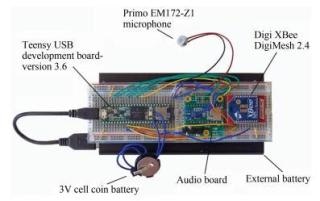Mar 21 2019
An international research team has developed an innovative sensor network with the ability to monitor two vital activities—biodiversity, or the wide range of life, in a specific ecosystem or habitat, and identification of potential illegal activities like poaching or logging in restricted areas.
 Set-up of a low-cost and energy efficient wireless audio recorder. (Image credit: C.M. Leung, PhD, University of British Columbia)
Set-up of a low-cost and energy efficient wireless audio recorder. (Image credit: C.M. Leung, PhD, University of British Columbia)
The new wireless recording network has the ability to record the sounds of an ecosystem with the same quality as devices that have been employed until now; however, it is considerably more cost-effective and energy-efficient. This network is made of edge computing recorders, that is, devices for sampling and processing data at the recording location, with power savings of nearly 280%. It exhibits the potential to streamline the monitoring process of biodiversity to a greater extent and deals with the emergent global need for innovative assessment techniques needed to maintain the biodiversity balance across the globe.
In this paper, we propose a low cost solution for an audio recorder with onboard audio processing, as part of a wireless sensor network. The developed audio recorder can be used in several different use cases for which no cost effective, scalable biodiversity monitoring solution currently exists, such as to monitor pollinating insects, or to assess the condition of tropical forests by observing vocal animals. Our tests demonstrate that a collection of acoustic sounds recorded in 1 minute can arrive at the server only 30 seconds after the recording has finished, affording near real-time performance which could be of great value in tracking endangered species, or identifying illegal activity such as logging or poaching in protected areas.
Victor C. M. Leung, PhD, Corresponding Author and Professor, Department of Electrical and Computer Engineering, University of British Columbia.
The research was reported in IEEE/CAA Journal of Automatica Sinica in January 2019.
It is vital to know what species occupy an ecosystem and the number of each kind that are there to gain insights into the structure and function of an ecosystem and to predict future changes. Since the biodiversity levels of a balanced ecosystem are healthy, it is sufficiently strong to endure stresses like predators and climate change. Hence it is very essential to maintain the equilibrium of the ecosystem to ensure its survival. Biodiversity can be tracked to ensure its balance by monitoring sounds made by animals emit when they communicate within their surroundings.
This is also known as passive acoustic monitoring, and it has turned out to be a robust technique for preserving the survival of an ecosystem. But the amount of collected data mandates automated techniques with the potential to sample the sounds across time and space and to relay the data to an accessible storage location. Since this needs a large amount of power, it is still a technical challenge. Hence, at present, there is an emergent need for innovative assessment techniques that are not just energy efficient but also cost effective.
Traditional biodiversity survey methods involve the identification and logging of species, by experts at the recording location, based on what they see and hear at locations of interest. This implies several disadvantages like the vast amount of time and money to get constant results over a long period of time and a wide geographical distance, lack of reliability due to human error. Based on the growing recognition of the ecological significance of the acoustic environment, passive acoustic monitoring is emerging as a promising solution to the urgent, global need for new biodiversity assessment methods.
Victor C. M. Leung, PhD, Corresponding Author and Professor, Department of Electrical and Computer Engineering, University of British Columbia.
The goal of the researchers is to optimize the versatility of the system and its efficiency in the future. They also intend to improve battery life by executing a system sleep mode and integrating solar power as a secondary source of power for long-lasting operation. Moreover, their goals are to minimize the costs further, to enhance the audio quality, to increase the number of nodes and install antennas between them to enable them to cover a huge network. “A detailed analysis to identify the balance between range and power consumption might be an interesting topic for future enhancements of the wireless recorders,” commented Professor Leung.